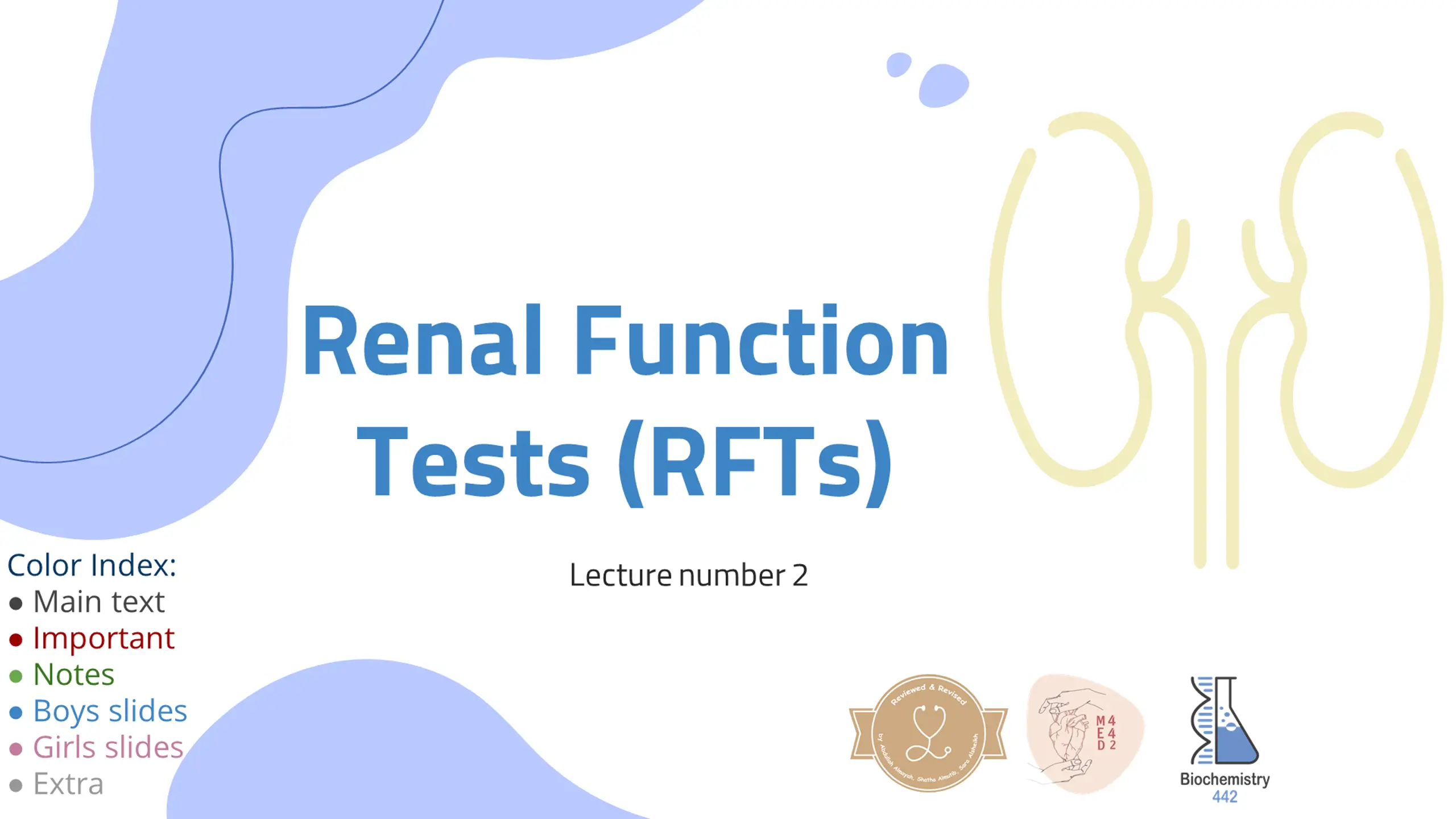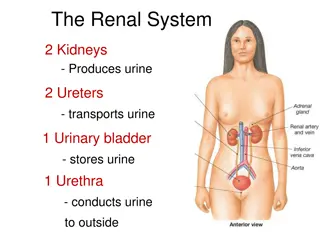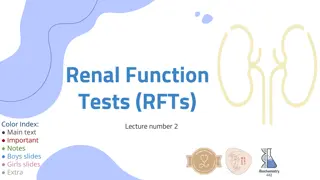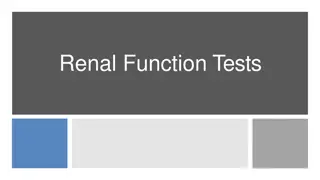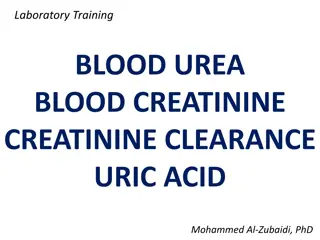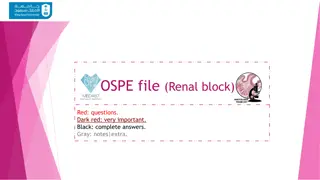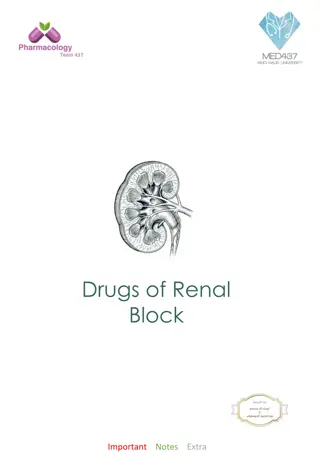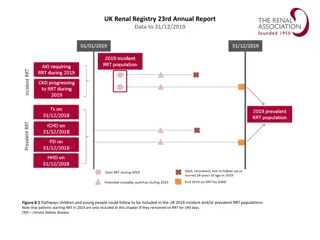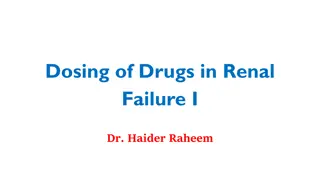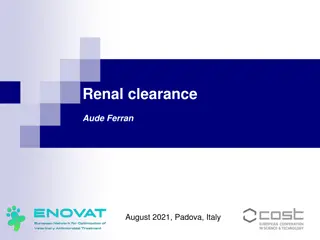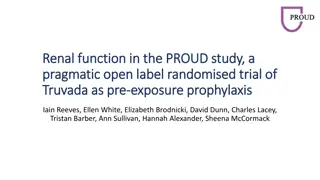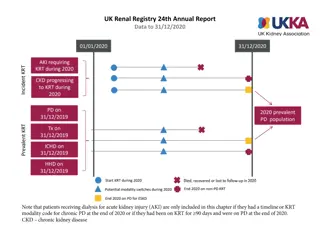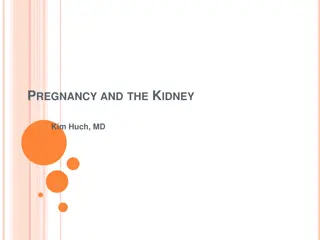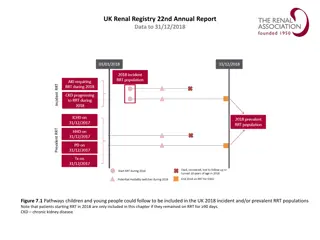Renal Function Tests (RFTs)
An overview of the functional units of the kidney, including the nephron, and the various functions performed by the kidneys. It also covers laboratory tests used to assess kidney function.
Download Presentation

Please find below an Image/Link to download the presentation.
The content on the website is provided AS IS for your information and personal use only. It may not be sold, licensed, or shared on other websites without obtaining consent from the author.If you encounter any issues during the download, it is possible that the publisher has removed the file from their server.
You are allowed to download the files provided on this website for personal or commercial use, subject to the condition that they are used lawfully. All files are the property of their respective owners.
The content on the website is provided AS IS for your information and personal use only. It may not be sold, licensed, or shared on other websites without obtaining consent from the author.
E N D
Presentation Transcript
Renal Function Tests (RFTs) Lecture number 2 Color Index: Main text Important Notes Boys slides Girls slides Extra
objectives To have a knowledge about functional units and normal functions of the kidney. To have an idea about some examples of renal disease. To know laboratory routine kidney function tests (KFTs). To know other laboratory KFTs.
Functional units: The nephron is the functional unit of the kidney. Each kidney contains about 1,000,000 to 1,300,000 nephrons. The nephron is composed of glomerulus and renal tubules. The nephron performs its homeostatic function by ultra filtration at glomerulus and secretion and reabsorption at renal tubules. Kidney Functions Hormonal Function Metabolic Function Regulation of Excretion of -secretion of erythropoietin. -activation of vitamin D. -activation of angiotensinogen by renin. -water and electrolyte balance. -acid base balance. -arterial blood pressure. -metabolic waste products. -foreign chemicals. -site for gluconeogenesis.
In Male slides Only Each nephron is a complex apparatus comprised of five basic parts: 1-Glomerulus 2-Proximal Convoluted Tubule Functions to filter incoming blood. Returns the bulk of each valuable substance back to the blood circulation. 75% of the water, sodium, and chloride. 100% of the glucose (up to the renal threshold). almost all of the amino acids, vitamins, and proteins. varying amounts of urea , uric acid, and ions, such as magnesium , calcium and potassium. (With the exception of water and chloride ions because they reabsorbed passively , the process is active that is the tubular epithelial cells use energy to bind and transport the substances across the plasma membrane to the blood). Secretes products of kidney tubular cell metabolism, such as hydrogen ions, and drugs, such as penicillin. Factors facilitate filtration: high pressure in the glomerular capillaries, which is a result of their position between two arterioles. the semipermeable glomerular basement membrane, which has a molecular size cutoff value of approximately 66,000 Da. The volume of blood filtered per minute is the glomerular filtration rate (GFR), and its determination is essential in evaluating renal function.
In Male slides Only 3-Loop of Henle Facilitates the reabsorption of water, sodium, and chloride. 4-Distal Convoluted Tubule The filtrate entering this section of the nephron is close to its final composition (which is urine). Effects small adjustments to achieve electrolyte and acid-base homeostasis (under the hormonal control of both antidiuretic hormone ADH and aldosterone). The osmolality in the medulla in this portion of the nephron increases steadily from the corticomedullary junction inward . 5-Collecting Duct The collecting ducts are the final site for either concentrating or diluting urine. The hormones ADH and aldosterone act on this segment of the nephron to control reabsorption of water and sodium. Chloride and urea are also reabsorbed here (partially). The collecting ducts in the medulla are highly permeable to urea so urea will diffuse down its concentration in gradient out of the tubule and into the medulla interstitium, increasing its osmolality. The distal convoluted tubule is much shorter than the proximal tubule, with two or three coils that connect to a collecting duct.
Renal diseases: Many diseases affect renal function. In some, several functions are affected. In others, there is selective impairment of glomerular function or one or more of tubular functions. Most types of renal diseases cause destruction of complete nephron. Examples of renal disease Renal calculi (stones). Renal hypertension. Renal failure (acute and chronic). Renal obstruction and Renal calculi (stones). 2 5 1 3 4 Tubular disease: Proximal or distal tubular renal acidosis (TRA). Glomerular disease: -Acute and chronic glomerulonephritis. -Nephrotic syndrome.
Routine KFTs include the measurement of: Serum creatinine (Cr). Serum urea. Creatinine clearance. Electrolyte. Both serum Cr and creatinine clearance are used as kidney function tests to : Confirm the diagnosis of renal disease. Give an idea about the severity of the disease. Follow up the treatment.
Serum creatinine (55-120 mol/L in adult): Unit is very important Creatinine isNOT reabsorbed by the renal tubules. Creatinine is the end product of creatine catabolism. 98% of the body creatine is present in the muscles where it functions as store of high energy in the form of creatine phosphate. Plasma creatinine is an endogenous substance not affected by diet. Plasma creatinine remains fairly constant throughout adult life. About 1-2 %of total muscle creatine or creatine phosphate pool is converteddaily to creatinine through the spontaneous, non enzymatic loss of water or phosphate. Creatinine in the plasma is filtered freely at the glomerulus and secreted by renal tubules (10 % of urinary creatinine). We can ignore it
Creatinine clearance: The glomerular filtration rate (GFR) provides a useful index of the number of functioning glomeruli. It gives an estimation of the degree of renal impairment by disease. What does clearance mean?? There is a limitationof this equation which is the the volume of urine because maybe there will be some mistakes during collecting the urine. Clearanceis the volume of plasma cleared from the substance excreted in urine per minute. It could be calculated from the following equation: U= Concentration of creatinine in urine mol/l Clearance (ml/min) = U x V V= Volume of urine per min P P= Concentration of creatinine in serum (plasma) mol/l
Accurate measurement of GFR by clearance tests requires determination of the concentration in plasma and urine of a substance that is: Creatinine clearance: Count. In the 20-40 year old adults. Creatinine clearance is usually about 110 ml/min. Freely filtered at glomeruli. Neither reabsorbed nor secreted by tubules. In individuals over 8o years of age Its concentration in plasma needs to remains constant throughout the period of urine collection. It falls slowly but progressively to about 70 ml/min. ? Decrease in muscle mass Better if the substance is present endogenously. In Children. Not costly Easily measured. The GFR should be related to surface area, when this is done, results are similar to those found in young adults. Creatinine meets most of these criteria. Except that creatinine is secreted by 5-10%,
Cockcroft-Gault Formula for Estimation of GFR An example is the Cockcroft-Gault Formula: As indicated above, the creatinine clearance is measured by using a 24- hour urine collection, BUT this does introduce the potential for errors in terms of completion of the collection. GFR = K x (140 age) x Body weight Serum creatinine ( mol/L) An alternative and convenient method is to employ various formulae devised to calculate creatinine clearance using parameters such as : K is a constant that varies with sex: 1.23 for male 1.04 for females. The constant K is used as females have a relatively lower muscle mass. How to convert creatinine concentration from MG/DL to micromol/L ? THE CONVERSION FACTOR IS ( 88.4 ) e.g: 1mg/dl = 88.4 micromol/l - - - - - - serum creatinine level, sex, age, weight of the subject. Cockcroft-Gault Formula for Estimation of GFR: Limitations It should not be used if : 1) Serum creatinine is changing rapidly in bodybuilding 2) The diet is unusual, e.g., strict vegetarian 3) Low muscle mass, e.g., muscle wasting 4) Obesity We said that creatinine is an endogenous substance not affected by diet. BUT here it is affected indirectly by causing a decrease in muscle mass due to the diet. First 3 points affect (serum creatinine) and forth point affect body weight in the equation
Serum Cr is a better KFT than creatinine clearance because: Normal adult reference values: Serum creatinine is more accurate. Female s Dr: no numbers in the exam even in the cases they will give you the reference values Serum creatinine level is constant throughout adult life Urinary excretion of creatinine is 0.5 -2.0 g per 24 hours in a normal adult, varying according to muscular weight. Creatinine clearance is only recommended in the following conditions: Serum creatinine : 55 120 mol/L Creatinine clearance: 90 140 ml/min (Males) 80 125 ml/min (Females) Patients with early ( minor ) renal disease. A raised serum creatinine is agoodindicatorof impaired renalfunction Assessment of possible kidney donors. Detection of renal toxicity of some nephrotoxic drugs. But normal serum creatinine does not necessarily indicate normal renal functionas serum creatinine may not be elevated until GFR has fallen by as much as 50% Cr : creatinine KFT : kidney function test
Note that the serum urea is higher than serum creatinine due to the unit mmol is higher than mol Serum Urea ( 2.5-6.6 mmol/L) in adult: Urea is formed in the liverfrom ammonia released from deamination of amino acids. Amino Acid Ammonia Urea Ammonia has no charge, so it could defuse to the brain from BBB. Thus it s harmful and should be converted to urea As a kidney function test, serum urea is inferior to serum creatinine because: High protein diet increases urea formation. Unlike creatinine Any condition of high proteins catabolism (Cushing syndrome, diabetes mellitus, starvation, thyrotoxicosis)increase urea formation. 50 % or more of urea filtered at the glomerulus is passively reabsorbed by the renal tubules.
Normal values of Internal Chemical Environment controlled by the Kidneys: Examples of other KFTs: Cystatin C. Microalbumin. 2-Microglobulin (11,800 Da). Myoglobin (16,900 Da) SODIUM 135 to 145 mEq/L POTASSIUM 3.5 to 5.5 mEq/L Numbers are not important CHLORIDES 100 to 110 mEq/L BICARBONATE 24 to 26 mEq/L Remember that microalbumin means a small amount of Albumin not another type CALCIUM 8.6 to 10 mg/dl MAGNESIUM 1.6 to 2.4 mg/dl PHOSPHORUS 3.0 to 5.0 mg/dl Female s Dr said: no number have to be memorized here URIC ACID 2.5 to 6.0 mg/dl Male s Dr said: This table is useful but you don t need to memorize it pH 7.4 CREATININE 0.8 to 1.4 mg/dl BUN (Blood Urea Nitrogen) 15 to 20 mg/dl
MCQs Q1/ which of the following is one of the kidney s hormonal Functions: A/ activation of vitamin C Q2/ most types of renal diseases cause: B/ activation of vitamin D C/ activation of vitamin B D/ activation of vitamin A A/ dysfunction of complete nephron Q3/ which of the following is not used to measure kidney function: B/ impairment of glomerular function C/ destruction of tubular functions D/ vasoconstriction of afferent arteriole B/ serum urea C/ urea clearance A/ serum creatinine Q4/ serum creatinine level in adults is : D/ creatinine clearance A/ 0.5g - 2g Q5/ serum urea is superior to serum creatinine As a kidney function test because: C/ 70 ml/min D/ 55-120 mmol/L B/ 55-120 mol/L A/creatinine is constant B/ urea levels increase with high protein intake C/serum urea is inferior to serum creatinine D/ none Q6/ urea is formed in : A/ liver B/ kidneys C/ muscles D/ not formed endogenously
SAQs Q1/ both serum Cr and creatinine clearance are used as kidney function test to? Q2 / enumerate 4 requirements for accurate measurement of GFR by clearance tests Q3 / enumerate the limitations of Cockcroft-Gault Formula . Q1 1- confirm the diagnosis of renal disease. 2- give an idea about the severity of the disease. 3- follow up the treatment. Q2- Freely filtered at glomeruli. Neither reabsorbed nor secreted by tubules. ts concentration in plasma needs to remains constant throughout the period of urine collection. Better if the substance is present endogenously Easily measured. - - - - Q3 serum creatinine is changing rapidly / The diet is unusual, e.g., strict vegetarian Low muscle mass, e.g., muscle wasting / Obesity
Our Team Leaders Team members Abdulrahman Ateeq Raseel Alwehibi Muhannad almuadi Sara Alotaebe Khaled Abdulaziz Mashael Alsuliman Mohammed Ibn Saqyan Ahmad Almarshed Hoor Aloraini Ali Al-Jabaan Nouf Aldhalaan Abdul Rahman Al Qurashi Fatima Halawo Abdullah Al Shehri Biochemksumed442@gmail.com Editing files
